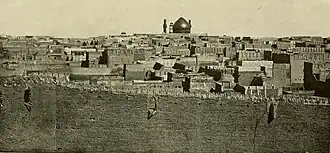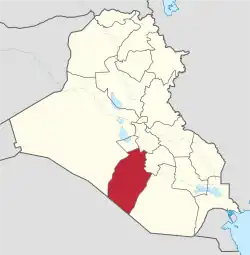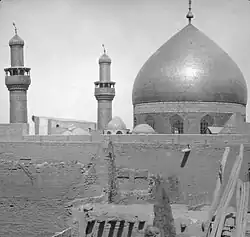Wahhabi raids on Najaf
| Wahhabi raids on Najaf (1801-1806) | |||||||
|---|---|---|---|---|---|---|---|
| Part of Iraqi–Wahhabi War | |||||||
 The Ali Shrine in Najaf Governorate | |||||||
| |||||||
| Belligerents | |||||||
|
| |||||||
| Commanders and leaders | |||||||
|
|
| ||||||
| Casualties and losses | |||||||
| 15.000 Killed |
The first: 10 Killed The Second and Third: Unknown | ||||||
The Wahhabi raids on Najaf (Arabic: الغارات الوهابيه على النجف) were a series of Wahhabi campaigns outside the Arabian Peninsula aimed at expanding the Emirate of Diriyah and spreading the Wahhabi doctrine. These campaigns were hostile toward the Shia and targeted Iraq, as well as aimed to destroy the shrines of the Al-Ataba Al-Alawiya. The Wahhabi campaigns on Najaf began in the early 19th century.[1][2]
Background
When the Ottoman Empire was weakening day by day, the Wahhabis were looting and expanding in the Arabian Peninsula.[3] Among their expansions was into Iraq, where they sought to destroy the shrines of Shia Imams. One of their campaigns was the raids on Najaf, which took place between 1801 and 1806, during the leadership of the Wahhabi Imams Abdulaziz bin Muhammad and Saud bin Abdulaziz (son of Abdulaziz bin Saud). However, the most infamous attack on Iraq was the looting of Karbala, in which 2,000[4][5] to 5,000[6] people were killed at the hands of the Wahhabis.

There are also accounts stating that there was a plague in Baghdad, and from this situation the Wahhabis, under Saud bin Abdulaziz, took advantage and launched their first campaign against Najaf sometime between 1800 and 1801. However, they clashed with the people of Basra, suffering an unknown number of casualties, before returning to Najd,[7] their base in the Emirate of Diriyah.
The First Siege of Najaf (1801)
When the Wahhabi army attacked Karbala in 1802,[8] Saud bin Abdulaziz began his next campaign toward Najaf, specifically targeting the shrine of Imam Ali to loot it in the same way as Karbala. At that time, it was the Eid al-Ghadir[a] festival, so most people were in Najaf, fearing that the shrine of Imam Ali would be robbed and plundered.[9]
Knowing that the Ottoman state did not support the shrines of the Imams, they moved the jewels and other treasures of Najaf from the shrine of Imam Ali to Baghdad to prevent them from being stolen. The Shia religious authority, Sheikh Jafar Kashif al-Ghita organized a mobilization in Najaf, where people armed themselves and fortified the city by blocking entrances with large rocks and stones.[10]
According to sources, when the Wahhabi army reached Najaf,[11] they besieged it with a force of 12,000 to 15,000[12][13] soldiers. Saud began firing on the city, killing 5[14] people that night. The Wahhabis remained outside the walls until the following night, after which they withdrew. In this battle, 10 people from Najaf were killed,[15] along with 700 soldiers from the Wahhabi army.[16]
The Second Siege of Najaf (1803)
Four years after the first attack, Sheikh Jafar Kashif al-Ghita, with the assistance of Grand Vizier Muhammad Husayn Khan,[b] oversaw the construction of a wall, a deep trench, towers, watchtowers, and guard posts around Najaf. The fortifications included various openings in their upper levels for positioning cannons and rifles, transforming the city into a military zone that was difficult to penetrate.
A few months after this construction, Saud al-Kabir launched a campaign on Najaf with 10,000 to 15,000 Wahhabi[17] soldiers. One reason for this campaign was his desire to avenge his father, who had been killed by a Shia man[18] named Mulla ‘Uthman—reported by some sources to have been Afghan, others Kurdish, and others Iraqi from Karbala. However, the campaign ended in a major failure.
The Third Siege of Najaf (1806)

Three years after the previous siege, the Wahhabis launched a new siege on Najaf with roughly the same number of troops as in the earlier campaigns. This time, the majority of the city’s inhabitants fled, fearing a repeat of what had happened in Karbala. However, some remained—most notably the Shia religious authority of Najaf at the time, Sheikh Jafar Kashif al-Ghita’.
At that point, Najaf had only about 200 soldiers.[19] Alongside Kashif al-Ghita’ was Sheikh Jawad al-Husayni, who was then writing the fifth volume of his book Miftah al-Karama. He recorded:
“This volume was completed at the beginning of the month of Rabi‘ al-Awwal, 1221 AH, amid unsettled conditions and preoccupation of mind due to what befell us from the accursed outsider in the land of Najd. He invented what he invented in religion, permitted the blood of Muslims, and destroyed the shrines of the infallible Imams… In the year 1221 AH, on the ninth night of the month of Safar, an hour before dawn, he attacked us in Najaf al-Ashraf while we were unprepared—so much so that some of his men climbed the wall and nearly took the city. Then, manifest miracles and great blessings appeared from the Commander of the Faithful (peace be upon him), many of his soldiers were killed, and he withdrew in defeat. Praise be to Him in all circumstances.”
Thus, the people of Najaf won their third consecutive victory over the Wahhabi forces. Even if it had succeeded, before this attack the Wahhabis had already entered the Hijaz and demolished the graves of the Imams of al-Baqi: Hasan ibn Ali, Ali al-Sajjad, Muhammad al-Baqir, and Jafar al-Sadiq—who are revered by Shia Muslims of all sects.
Aftermath
See also
Notes
- ^ A third festival among the Shia commemorating the appointment of Ali as caliph on the day of Ghadir Khumm.
- ^ The vizier of Fath-Ali Shah
References
- ^ Bosworth, The New Islamic Dynasties, p. 232 [بوزورث، السلالات الاسلامية الجديدة، ص232] (in Arabic).
- ^ Al-Husayni Al-'Amili, Miftah al-Karama, vol. 17, p. 188 [لحسيني العاملي، مفتاح الكرامة، ج17، ص188.] (in Arabic).
- ^ Nakash,The Shi'is of Iraq, p. 28-36.
- ^ Khatab, Sayed (2011). Understanding Islamic Fundamentalism: The Theological and Ideological Basis of Al-Qa'ida's Political Tactics. Oxford University Press. ISBN 9789774164996.
- ^ Vasilev, A. M. (2014-05-22). The History of Saudi Arabia. Saqi. ISBN 978-0-86356-779-7.
- ^ Litvak, Meir (2010). KARBALA.
- ^ Al-Mahbuba, The Past and Present of Najaf, vol. 1, p. 326 [آل محبوبة، ماضي النجف وحاضرها، ج1، ص326.] (in Arabic).
- ^ Al-Ta'mah, The Heritage of Karbala, p. 116 [آل طعمة، تراث كربلاء، ص116.] (in Arabic).
- ^ Al-Tai, The Wahhabis: Khawarij or Sunnis?, p. 245 [الطائي، الوهابيون خوارج أم سنة، ص245.] (in Arabic).
- ^ Al-Barqi, The Wahhabi Campaign on Najaf, p. 123 [البرقي، حملة وهابي ها به نجف، ص123.] (in Arabic).
- ^ Sabhar, Nasikh al-Tawarikh, vol. 1, p. 119 [سبهر، ناسخ التواريخ، ج1، ص119.] (in Arabic).
- ^ Sabhar, Nasikh al-Tawarikh, vol. 1, p. 119 [سبهر، ناسخ التواريخ، ج1، ص119] (in Arabic).
- ^ "Founders of Wahhabi Doctrines: The Wahhabi Attack on Najaf Ashraf," p. 50 [«بنیانگذاران عقائد وهابیت: حمله وهابیها به نجف اشرف»، ص50.] (in Arabic).
- ^ Al-Mahbuba, The Past and Present of Najaf, vol. 1, p. 325 [آل محبوبة، ماضي النجف وحاضرها، ج1، ص325.] (in Arabic).
- ^ Al-Barqi, The Wahhabi Campaign on Najaf, p. 124 [البرقي، حملة وهابي ها به نجف، ص124.] (in Arabic).
- ^ Sabhar, Nasikh al-Tawarikh, vol. 1, p. 119 [سبهر، ناسخ التواريخ، ج1، ص119.] (in Arabic).
- ^ Al-Mahbuba, The Past and Present of Najaf, vol. 1, p. 326 [آل محبوبة، ماضي النجف وحاضرها، ج1، ص326] (in Arabic).
- ^ Rasul al-Karkukli, Dawhat al-Wuzara' – Beirut, n.d., p. 227 [Rasul al-Karkukli, Dawhat al-Wuzara’ – Beirut, n.d., p. 227.] (in Arabic).
- ^ Social Glimpses from the Modern History of Iraq, vols. 1–8, vol. 1 [لمحات اجتماعية من تاريخ العراق الحديث 1-8 ج1] (in Arabic).
- ^ Ja'far Mahbuba, The Past and Present of Najaf – Najaf, 1958, vol. 1, p. 327 [جعفر محبوبة (ماضي النجف وحاضرها) - النجف ١٩٥٨ ج ١ ص ٣٢٧ .] (in Arabic).